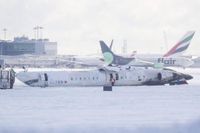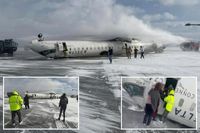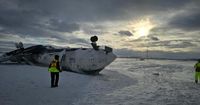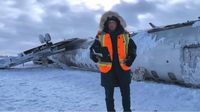On February 17, 2025, a Delta Air Lines flight, operated by Endeavor Air, made a crash landing at Toronto Pearson International Airport, flipping upside down and resulting in injuries to 21 passengers. The preliminary report released by the Transportation Safety Board of Canada (TSB) on March 20 revealed alarming details about the descent of Delta Flight 4819. This incident has raised serious questions about aviation safety, particularly concerning the crew’s actions during challenging conditions.
The flight, arriving from Minneapolis with 80 individuals aboard—76 passengers and four crew members—was reported to have descended at an excessive rate amidst high winds. The TSB's preliminary findings show that a safety warning alert was triggered just 2.6 seconds before landing, indicating a critical “high rate of descent.” Aviation experts are weighing in on the details, noting that the aircraft landed at a sink rate of approximately 1,100 feet per minute, far exceeding the recommended rate of descent for a safe landing.
As high winds were reported—gusting up to 35 knots—flight crews must have expected turbulence during their approach. However, it seems there may have been insufficient corrective action taken. “It appears that hard landing was hard enough to break the airplane,” said Kit Darby, a U.S.-based aviation consultant. He elaborated that the aircraft’s speed upon touching down was far beyond acceptable limits, and that the lack of proper flaring of the nose caused the landing gear to fracture upon impact.
According to the aviation safety report, upon touching down, the right main landing gear gave way, which led to a sequence of catastrophic structural failures. The right wing detached, resulting in a significant fire as jet fuel was released. Passengers recounted the experience of being upended, trapped in their seats as the fuselage turned upside down.
Despite the severe nature of the incident, all individuals aboard survived, and the injured were released from local hospitals within days. Delta Air Lines issued a statement emphasizing their commitment to safety and engagement with the ongoing investigation. The company has also offered compensation of $30,000 to each passenger as a gesture of goodwill, amounting to a potential payout of $2.3 million should everyone accept the offer.
In the aftermath, the crew's actions are under scrutiny. The first officer, who had limited flight experience, had accumulated only 1,422 hours of total flight time prior to this incident, raising concerns about the decision-making and skills employed during the stressful landing. The TSB intends to investigate the flight crew's training and how they handled the rapidly deteriorating situation. “We have lots of work to do yet,” said Ken Webster, the TSB’s lead investigator, stressing the complexity of understanding how each factor contributed to the incident.
There are indications that while weather conditions played a role, human factors and pilot performance will be key topics analyzed in this investigation. “Landing in gusty conditions is one thing the pilots are trained to do; it’s not something that’s abnormal,” remarked one expert on aviation safety. Investigators will need to determine if the pilots failed to notice crucial visual clues and warnings regarding the descent rate. As John Cox, a retired commercial airline captain, stated, “The sink rate was almost double what it should be,” hinting at potential negligence in piloting.
The TSB's preliminary report suggests that it is too early to draw definitive conclusions about a single cause for the crash. Instead, investigations will explore various interconnected factors that could have contributed to the plane's unfortunate circumstances, including mechanical failures. Some components were damaged in the crash, but no pre-existing issues have been identified so far. The shock struts on the plane, designed to manage a touchdown at no greater than 12 feet per second, highlighted the severity of the landing as the plane impacted at 18.3 feet per second.
Further analysis will focus on the aircraft’s landing techniques and pilot training methods, with the goal of ensuring that such an accident does not reoccur in the future. Experts point out that while investigations seek to understand the specifics, the aviation industry must remain vigilant in ensuring pilot error is minimized through robust training programs.
As legal actions begin to arise from this incident, passengers continue to experience the emotional and physical impact of what occurred. Andres Pereira, a legal representative of one of the injured passengers, indicated, “Our client has suffered significant injuries because of Delta’s negligence.” With lawsuits already filed in multiple jurisdictions, Delta has yet to comment directly on the litigation but continues to express its commitment to support the ongoing investigations into the crash.
As authorities work diligently to uncover the truth behind Delta Flight 4819's crash landing, the aviation industry faces immediate pressure to analyze and reform their safety protocols in the wake of public scrutiny. In an era where air travel is a vital mode of transportation, ensuring passenger safety is paramount. This incident serves as a potent reminder that every decision in the cockpit can impact countless lives.





